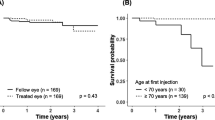Abstract
To investigate the early effects of two intravitreal (IV) anti vascular endothelial growth factor agents (anti-VEGF), bevacizumab and ranibizumab, on intraocular pressure (IOP) and central corneal thickness (CCT) within the first post-injection month. This prospective study comprised 109 eyes of 109 adult cases who had IV bevacizumab or ranibizumab injections because of age-related macular degeneration (ARMD), retinal venous occlusion (RVO), diabetic retinopathy, and macular edema or central serous chorioretinopathy (CSCR). None of the cases had medical histories of any kinds of glaucoma or increased IOP and IV injection before and all of them underwent a detailed ocular examination including measurements of IOP by non-contact tonometer and CCT by ultrasonic pachymeter pre-injection. IOP measurements were repeated at 30 min and 1st, 7th, and 30th day after the injection. CCT measurements were repeated at the 7th and 30th post-injection day. Paired sample t tests were used for the statistical analysis in order to evaluate the significance of changes in IOP and CCT. The mean age of 56 male and 53 female cases was 63.58 ± 11.04 years. Fifty-six cases (51.4 %) had diabetic retinopathy, 33 cases (30.3 %) had ARMD, 11 cases (10.1 %) had RVO, and 9 cases (8.3 %) had CSCR. Bevacizumab was used in 97 (89 %) cases and ranibizumab was used in 12 (11 %) cases. The IOP increased significantly 30 min after the injection (p < 0.001) but significant decreases were observed at the 1st, 7th, and 30th day post-injection (p < 0.001). No significant differences were observed in CCT between pre-injection and 7th and 30th post-injection day values (p = 0.924 and p = 0.589, respectively). Intravitreal bevacizumab and ranibizumab injections can cause hyper acute increase in IOP because of vitreal expansion but this effect is generally reversible in non-glaucomatous cases.
Similar content being viewed by others
References
Solomon SD, Lindsley K, Vedula SS, Krzystolik MG, Hawkins BS (2014) Anti-vascular endothelial growth factor for neovascular age-related macular degeneration. Cochrane Database Syst Rev 8:CD005139. doi:10.1002/14651858.CD005139.pub3
Yeh S, Kim SJ, Ho AC, Schoenberger SD, Bakri SJ, Ehlers JP, Thorne JE (2015) Therapies for macular edema associated with central retinal vein occlusion: a report by the American Academy of ophthalmology. Ophthalmology 122:769. doi:10.1016/j.ophtha.2014.10.013
Küçükerdönmez C, Gelisken F, Yoeruek E, Bartz-Schmidt KU, Leitritz MA (2015) Switching intravitreal anti-VEGF treatment in neovascular age-related macular degeneration. Eur J Ophthalmol 25:51–56
Simó R, Sundstrom JM, Antonetti DA (2014) Ocular Anti-VEGF therapy for diabetic retinopathy: the role of VEGF in the pathogenesis of diabetic retinopathy. Diabetes Care 37:893–899
Kodjikian L, Decullier E, Souied EH, Girmens JF, Durand EE, Chapuis FR, Huot L (2014) Bevacizumab and ranibizumab for neovascular age-related macular degeneration: an updated meta-analysis of randomised clinical trials. Graefes Arch Clin Exp Ophthalmol 252:1529–1537
Schmid MK, Bachmann LM, Fäs L, Kessels AG, Job OM, Thiel MA (2015) Efficacy and adverse events of aflibercept, ranibizumab and bevacizumab in age-related macular degeneration: a trade-off analysis. Br J Ophthalmol 99:141–146
Shikari H, Silva PS, Sun JK (2014) Complications of intravitreal injections in patients with diabetes. Semin Ophthalmol 29:276–289
Van der Reis MI, La Heij EC, De Jong-Hesse Y, Ringens PJ, Hendrikse F, Schouten JS (2011) A systematic review of the adverse events of intravitreal anti-vascular endothelial growth factor injections. Retina 31:1449–1469
Morshedi RG, Ricca AM, Wirostko BM (2014) Ocular hypertension following intravitreal antivascular endothelial growth factor therapy: review of the literature and possible role of nitric oxide. J Glaucoma (Epub ahead of print)
SooHoo JR, Seibold LK, Kahook MY (2014) The link between intravitreal antivascular endothelial growth factor injections and glaucoma. Curr Opin Ophthalmol 25:127–133
Abedi G, Adelman RA, Salim S (2013) Incidence and management of elevated intraocular pressure with antivascular endothelial growth factor agents. Semin Ophthalmol 28:126–130
Lemos-Reis R, Moreira-Gonçalves N, Melo AB, Carneiro AM, Falcão-Reis FM (2014) Immediate effect of intravitreal injection of bevacizumab on intraocular pressure. Clin Ophthalmol 23:1383–1388
Bakri SJ, Pulido JS, McCannel CA, Hodge DO, Diehl N, Hillemeier J (2009) Immediate intraocular pressure changes following intravitreal injections of triamcinolone, pegaptanib, and bevacizumab. Eye 23:181–185
Gismondi M, Salati C, Salvetat ML, Zeppieri M, Brusini P (2009) Short-term effect of intravitreal injection of ranibizumab (Lucentis) on intraocular pressure. J Glaucoma 18:658–661
Cacciamani A, Oddone F, Parravano M, Scarinci F, Di Nicola M, Lofoco G (2013) Intravitreal injection of bevacizumab: changes in intraocular pressure related to ocular axial length. Jpn J Ophthalmol 57:63–67
Pérez-Rico C, Benítez-Herreros J, Castro-Rebollo M, Gómez-Sangil Y, Germain F, Montes-Mollón MA, Teus MA (2010) Effect of intravitreal ranibizumab on corneal endothelium in age-related macular degeneration. Cornea 29:849–852
Segal O, Ferencz JR, Cohen P, Nemet AY, Nesher R (2013) Persistent Elevation of intraocular pressure following intravitreal injection of bevacizumab. IMAJ 15:420–423
Bakri SJ, McCannel CA, Edwards AO, Moshfeghi DM (2008) Persistent ocular hypertension following intravitreal ranibizumab. Graefes Arch Clin Exp Ophthalmol 246:955–958
Krohne TU, Eter N, Holz FG, Meyer CH (2008) Intraocularpharmacokinetics of bevacizumab after single use intravitreal injection in humans. Am J Ophthalmol 146:508–512
Güler M, Capkın M, Simşek A, Bilak S, Bilgin B, Hakim Reyhan A, Fırat M (2014) Short-term effects of intravitreal bevacizumab on cornea and anterior chamber. Curr Eye Res 39:989–993
Funding
The authors of this manuscript named received no financial support or funds and have no financial interests related to this manuscript.
Author information
Authors and Affiliations
Corresponding author
Additional information
Our presentation was approved by Ethical Committee of Numune Training Hospital, Ankara, Turkey.
Rights and permissions
About this article
Cite this article
Omay, E., Elgin, U., Sen, E. et al. The early effects of intravitreal anti vascular endothelial growth factor agents on intraocular pressure and central corneal thickness. Int Ophthalmol 36, 665–670 (2016). https://doi.org/10.1007/s10792-016-0171-1
Received:
Accepted:
Published:
Issue Date:
DOI: https://doi.org/10.1007/s10792-016-0171-1




